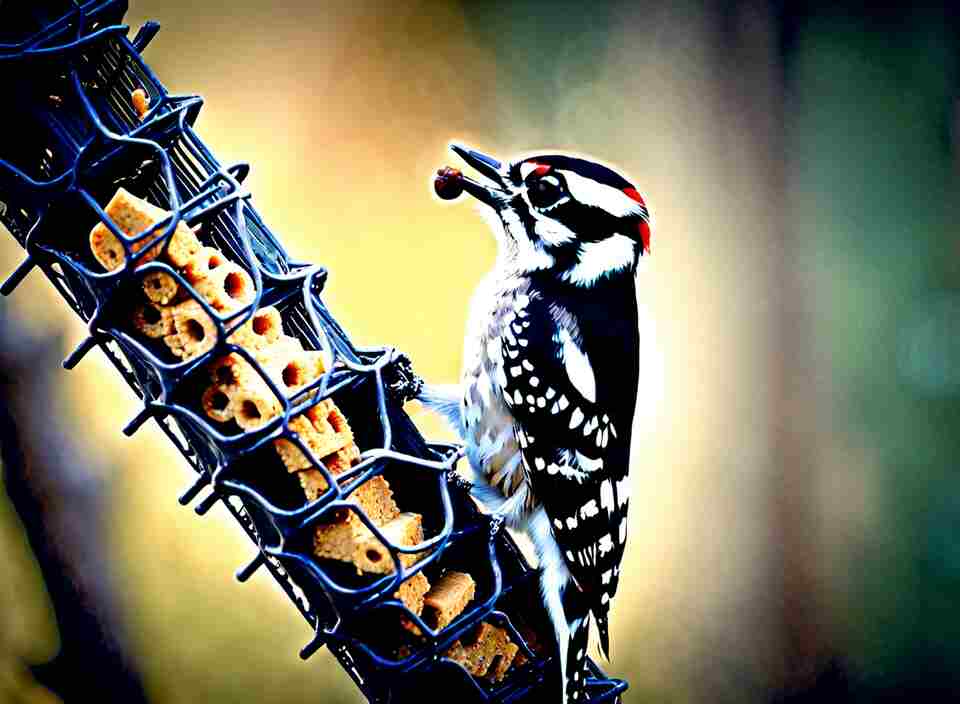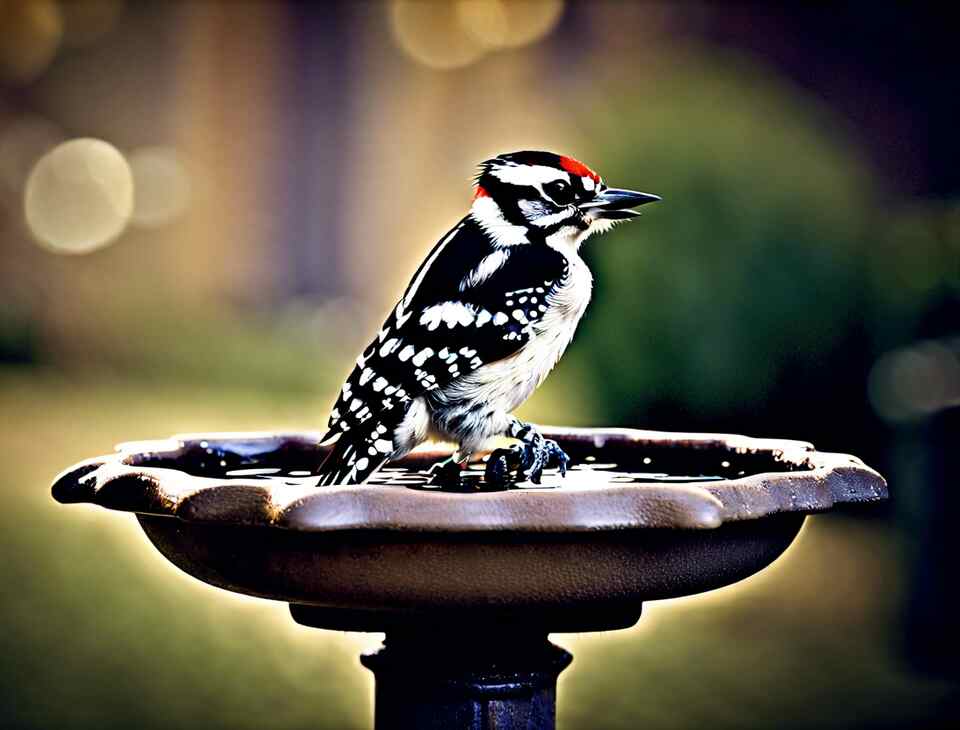
Hey there! Ready to turn your yard into a downy woodpecker paradise? Awesome! These little drummers bring so much joy and excitement to any backyard. Today, let’s roll up our sleeves and discover how to make our yard the ultimate hangout spot for these feathered friends. Get ready for a fun and rewarding journey!
Table of Contents
Key Takeaways:
- Provide a variety of food sources like suet, nuts, and seeds.
- Offer cozy nesting spots like birdhouses or old trees.
- Keep your yard pesticide-free to maintain a healthy environment.
- Install a birdbath or water feature for drinking and bathing.
- Maintain shrubs and trees for perching and foraging.

Attracting Downy Woodpeckers to Your Yard
Providing the Right Habitat
Downy woodpeckers are delightful backyard visitors, known for their distinctive black and white plumage and lively antics as they forage for insects and sap. To create an inviting environment for these charming birds, it’s essential to focus on providing the right habitat elements. Start by incorporating a variety of native trees and shrubs that offer an abundance of food sources, such as insects, larvae, and berries. Consider planting a mix of evergreen and deciduous species to ensure a year-round supply of sustenance.
Offering Suitable Nesting Sites
Downy woodpeckers are cavity nesters, meaning they prefer to build their homes in the hollows or decaying portions of trees. To cater to their nesting needs, consider installing specially designed birdhouses or leaving standing dead trees (snags) in your yard. Snags not only provide ideal nesting sites but also serve as a source of food as the woodpeckers search for insects and larvae within the wood.
Ensuring a Reliable Water Source
In addition to food, downy woodpeckers require a reliable water source for drinking and bathing. Incorporate a birdbath or small shallow dish filled with clean, fresh water in a sheltered, shaded area of your yard. Keep the water clean and replenished regularly to attract these feathered friends.
Providing Supplementary Feeding Opportunities
While downy woodpeckers will primarily forage for their natural food sources, you can further entice them by offering supplementary feeding opportunities. Hang suet feeders or offer a mixture of shelled nuts, seeds, and chopped fruit to supplement their diet. Be sure to position the feeders near dense vegetation or tree cover to provide a sense of safety and security for the birds.
Maintaining a Diverse Habitat
Downy woodpeckers thrive in a diverse and well-structured habitat. Ensure your yard includes a variety of tree species, both mature and young, as well as dense shrubs and groundcover. This multi-layered approach provides the birds with both foraging opportunities and protective cover from predators.
Avoiding Pesticides and Harmful Practices
To create a truly welcoming environment for downy woodpeckers, it’s essential to avoid the use of pesticides and other harmful practices that can negatively impact the local ecosystem. Opt for organic gardening methods and minimize the use of chemicals, as these can disrupt the natural food chain and pose a threat to the birds and other wildlife.
Observing and Appreciating the Downy Woodpeckers
As you transform your yard into a downy woodpecker haven, take the time to observe and appreciate these fascinating birds. Watch them as they forage, drill into trees, and engage in their lively displays. Take note of their behaviors and try to identify individual birds, as this can heighten your connection with the natural world.
By following these steps, you can create a thriving and welcoming habitat for downy woodpeckers, allowing you to enjoy their presence and the vibrant energy they bring to your outdoor space. Embrace the joy of birdwatching and the opportunity to connect with these dynamic, charismatic creatures right in your own backyard.
Effective Strategies for Attracting Downy Woodpeckers to Your Backyard Oasis
Attracting Downy Woodpeckers to Your Backyard Oasis
Provide a Diverse Buffet of Feeders
Downy woodpeckers are attracted to a variety of food sources, so it’s important to offer a diverse menu in your backyard. Include a mix of suet, seed-filled feeders, and even hummingbird nectar to cater to their diverse dietary needs. Place the feeders in strategic locations around your yard, such as near dense vegetation or tree trunks, to provide them with easy access and cover.
Create a Woodpecker-Friendly Habitat
Downy woodpeckers thrive in areas with a mix of mature trees, dead wood, and a variety of plant life. Encourage this habitat in your backyard by leaving some dead or dying trees or branches, which provide an excellent source of food and nesting sites for the birds. Additionally, plant native trees and shrubs that offer natural food sources, such as berries and insects.
Offer Suitable Nesting Sites
Downy woodpeckers are cavity nesters, so providing them with suitable nesting sites is crucial. Consider installing a few woodpecker-specific nest boxes or gourds in your yard, positioned in areas with good overhead cover and near food sources. Ensure the boxes have an appropriate entrance hole size and depth to accommodate the smaller downy woodpecker.
Provide a Water Source
Access to a reliable water source is essential for downy woodpeckers. Install a birdbath or small water feature in your yard, and keep it clean and filled with fresh water. Place the water source near dense vegetation or trees to provide the birds with a sense of security and cover.
Avoid Harsh Chemicals and Pesticides
Downy woodpeckers are sensitive to chemicals, so it’s important to avoid using harsh pesticides or herbicides in your yard. Instead, opt for natural, bird-friendly alternatives to maintain your garden and landscape. This will help protect the birds and ensure a healthy, sustainable habitat for them to thrive.
Patience and Persistence
Attracting downy woodpeckers to your backyard may take time and patience. Consistently maintain your feeders, water sources, and habitat, and be patient as the birds slowly discover your backyard oasis. With a little persistence, you’ll be rewarded with the sight of these energetic and entertaining visitors.
By implementing these strategies, you can create a welcoming and inviting environment for downy woodpeckers to visit and potentially even make their home in your backyard. Enjoy the opportunity to observe these fascinating birds up close and personal as they forage, nest, and contribute to the vibrant ecosystem of your outdoor space.

Conclusion
Transforming Your Yard into a Downy Woodpecker Haven
Providing the right habitat and food sources is key to attracting these charming birds to your backyard. By incorporating native plants, adding suet feeders, and creating nesting opportunities, you can transform your outdoor space into a haven for downy woodpeckers. Remember, the more diverse and wildlife-friendly your yard becomes, the more likely you’ll be to spot these captivating creatures flitting from tree to tree.
Effective Strategies for Attracting Downy Woodpeckers to Your Backyard Oasis
Downy woodpeckers are curious and energetic birds, and with a little effort, you can make your yard an irresistible destination for them. Start by planting a variety of native trees and shrubs that provide both food and shelter. Consider incorporating berry-bearing bushes, as well as dead or decaying wood, which offer the perfect foraging grounds for these insect-loving birds.
Supplement their natural food sources with strategically placed suet feeders. Downy woodpeckers love high-energy suet, and providing this nutritious treat can help attract them to your yard. Be sure to choose suet that is free of artificial preservatives and fillers, as this will ensure the birds are getting the nutrients they need.
Create nesting opportunities by installing woodpecker-friendly birdhouses or leaving snags (standing dead trees) in your landscape. Downy woodpeckers prefer cavities that are approximately 1 1/4 inches in diameter and 6-15 inches deep. Positioning these nesting sites near your other bird-attracting features can increase the chances of these feathered guests taking up residence.
Remember, patience and persistence are key when it comes to attracting downy woodpeckers. It may take some time for these birds to discover your backyard oasis, but with the right habitat and food sources in place, you’ll be well on your way to hosting a thriving population of these delightful creatures.
In the end, transforming your yard into a haven for downy woodpeckers is not only a rewarding endeavor, but it also plays a vital role in supporting the overall health and diversity of your local ecosystem. By providing a safe and nurturing environment for these unique birds, you’ll not only enjoy their captivating presence but also contribute to the preservation of an important species. So, roll up your sleeves, get creative with your landscaping, and prepare to be enchanted by the lively antics of the downy woodpecker in your own backyard.



